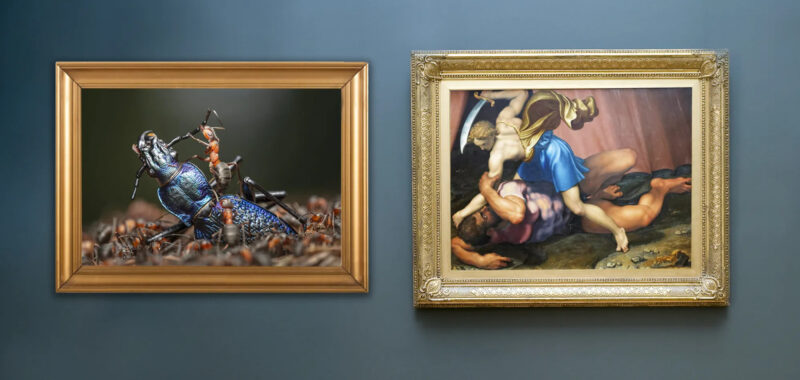
London’s Natural History Museum celebrated the 60th anniversary of its Wildlife Photographer of the Year (WPY) competition earlier this month. With over 59,000 entries from 117 countries to parse through for the 2024 competition, the WPY committee awarded 18 category winners and selected a total of 100 photos to include in the flagship exhibition now on view at the museum through the end of June.
While we at Hyperallergic can appreciate the invaluable biodiversity captured on a global scale through these photos, we couldn’t help but draw natural comparisons to the ever-growing art history canon — starting with the biblical story of David and Goliath, in this case rendered by 16th-century Mannerist painter Daniele da Volterra, which evokes the same energy of the victorious red wood ants making off with the hulking body of a deceased beetle in “The Demolition Squad” by Ingo Arndt (above). Some say that life imitates art, but from what we’ve seen, the truth of the matter is that art actually imitates wildlife!
Next up is Canadian photojournalist Shane Gross, who took the grand title for his energetic snapshot of tadpoles coursing through a lake in Vancouver Island that bears a strong resemblance to Dale Chihuly’s signature spiraling glass horns and globes. Chihuly’s chandelier in the rotunda at the Victoria and Albert Museum in London was an obvious comparison for its thematic color palette, but it’s also a needed reminder that there really is no competition with the luminosity and saturation found in nature.


Based in Germany, teenage photographer Alexis Tinker-Tsvalas managed to capture a springtail — no more than a tenth of an inch in size — face-to-face with the fruiting body of a slime mold from beneath a decaying log. The hexapod’s contemplation shares significant characteristics with the Ancient Greek mythological tyrant Sisyphus, who was cursed by the gods to push a boulder up a hill for eternity in the underworld. Thankfully for the springtail, there’s no eternal punishment in sight!


While I normally find seals to be very cute, this snapshot of an intrigued leopard seal in Antarctic waters is extremely unsettling. As in it may have been directly summoned from a Francis Bacon portrait …


I really may have outdone myself in terms of uncanny resemblances here. Compositionally, Sage Ono’s snapshot of tube-snout fish eggs gathered on the buoyancy bulbs of giant kelp in California’s Monterrey Bay National Marine Sanctuary directly mirrors that of Modigliani’s dual portrait of the Lipchitz couple. Both images keep an essence of neckline glamour as well!


The bond between mother and child is as sacred as it is instinctive — be it a baby toque macaque snuggling into its mother’s body, or Michelangelo’s rendition of Jesus post-crucifixion draped over the Virgin Mary’s lap in “Madonna della Pietà” (c. 1498–1499).


Now I need you to hear me out here … This next one might be a stretch.

This fabulously composed shot won young Alberto Román Gómez the title of Wildlife Photographer of the Year for ages 10 and under. With its stark lines, hanging chains, and minimal subject matter, I think we can also say he earned his photo a comparison to Piet Mondrian’s influential style:

If that wasn’t convincing enough, then the following will surely leave little to question. The endangered boto dolphins, known for their pink color and elongated snouts, are endemic to the Amazon River and its tributaries. In Thomas Peschak’s photo, a lone boto roams the shallow waters of a flooded forest scape that could very well be an extension of John Everett Millais’s “Ophelia” (1851–1852). One can only hope that the freshwater species doesn’t meet the same tragic fate …


Onto the Highly Commended entries (which are winners, in my heart, at least) — Samual Stone’s “Precious Rocks” brought to mind none other than the cauldron-headed bird hybrid chowing down on a person pooping out flying birds, a detail from Hieronymus Bosch’s fantastic rendition of “The Garden of Earthly Delights” (c. 1490–1510):


Right: Detail from Hieronymus Bosch’s “The Garden of Earthly Delights” (c. 1490–1510) (image via Wikimedia Commons)
And last but not least, we have Georgina Steytler’s photographed observation of a cluster of male Dawson’s burrowing bees swarming a female in an effort to mate immediately conjured up Gustav Klimt’s “The Kiss” (1907–1908) in both color palette and general energy … I suppose I’ll put a pin in it right now before I start pontificating about how intersectional feminism may as well expand to be interspecies feminism — there’s always another time for that.


Hrag Vartanian, Valentina Di Liscia, Lakshmi Amin Rivera, Shari Flores, and Lisa Yin Zhang contributed to this piece.

